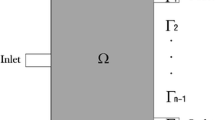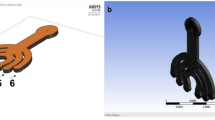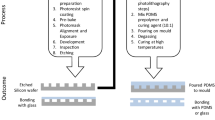Abstract
We present an automatic design process for microfluidic dilution network towards marine ecological toxicity assessment on microalgae. Based on the hydraulic–electric circuit analogy, we defined an abstract specification using computer-aided designing system. Several approaches, especially circuit partition, were applied to minimize design effort. Computational fluid dynamics (CFD) simulation was exploited to convert the electrics specification to fabrication model. We automatically designed the combinational-mixing-serial dilution microfluidics to generate parallel stepwise gradients for mixing chemicals (binary/ternary/quaternary mixture) using the present algorithm. We critically discussed design rules and evaluated the microfluidic performance by colorimetric analysis. To examine whether these microfluidic chips can be used for toxicity test on microalgae, single and joint toxic effects of heavy metals (copper, mercury, zinc, and cadmium) were examined on line. In all cases, dose-related toxic responses were successfully detected. These results provided a solution for designing resistive network using circuit partition and CFD-based optimization and a route to develop a promising user-friendly alternative for microalgae bioassays as well as cell-based screening experiments in risk assessment.






Similar content being viewed by others
References
MacDonald MP, Spalding GC, Dholakia K (2003) Microfluidic sorting in an optical lattice. Nature 426:421–424
Ye N, Qin J, Shi W, Liu X, Lin B (2007) Cell-based high content screening using an integrated microfluidic device. Lab Chip 7:1696–1704
Garcia-Alonso J, Greenway GM, Hardege JD, Haswell SJ (2009) A prototype microfluidic chip using fluorescent yeast for detection of toxic compounds. Biosens Bioelectron 24:1508–1511
Zheng G, Wang Y, Wang Z, Zhong W, Wang H, Li Y (2013) An integrated microfluidic device in marine microalgae screening application. Mar Pollut Bull 72:231–243
Lu L, Zheng GX, Yang YS, Feng CY, Liu FF, Wang YH (2017) Measurement of Giardia lamblia adhesion force using an integrated microfluidic assay. Anal Bioanal Chem 409:1451–1459
Kim C, Lee K, Kim JH, Shin KS, Lee K-J, Kim TS, Kang JY (2008) A serial dilution microfluidic device using a ladder network generating logarithmic or linear concentrations. Lab Chip 8:473–479
Walker GM, Monteiro-Riviere N, Rouse J, O’Neill AT (2007) A linear dilution microfluidic device for cytotoxicity assays. Lab Chip 7:226–232
Campbell K, Groisman A (2007) Generation of complex concentration profiles in microchannels in a logarithmically small number of steps. Lab Chip 7:264–272
Liu MC, Ho D, Tai YC (2008) Monolithic fabrication of three-dimensional microfluidic networks for constructing cell culture array with an integrated combinatorial mixer. Sens Actuators B Chem 129:826–833
Cooksey GA, Sip CG, Folch A (2009) A multi-purpose microfluidic perfusion system with combinatorial choice of inputs, mixtures, gradient patterns, and flow rates. Lab Chip 9:417–426
Irimia D, Geba DA, Toner M (2006) Universal microfluidic gradient generator. Anal Chem 78:3472–3477
Woerner M (2012) Numerical modeling of multiphase flows in microfluidics and micro process engineering: a review of methods and applications. Microfluid Nanofluid 12:841–886
Lee K, Kim C, Jung G, Kim TS, Kang JY, Oh KW (2010) Microfluidic network-based combinatorial dilution device for high throughput screening and optimization. Microfluid Nanofluid 8:677–685
Oh KW, Lee K, Ahn B, Furlani EP (2012) Design of pressure-driven microfluidic networks using electric circuit analogy. Lab Chip 12:515–545
Narayan KL, Rao KM, Sarcar MMM (2008) Computer aided design and manufacturing. Prentice-Hall, New Delhi
Shi CJR, Tian MW, Shi G (2006) Efficient DC fault simulation of nonlinear analog circuits: one-step relaxation and adaptive simulation continuation. IEEE Trans Comput Aided Des Integr Circuits Syst 25:1392–1400
Ma Y, Yeh LH, Qian S, Hsu JP, Tseng S (2014) Analytical model for surface charge property of pH-regulated nanorods. Electrochem Commun 45:75–78
Xuan X, Li D (2008) Joule heating in electrokinetic flow: theoretical models. In: Li D (ed) Encyclopedia of microfluidics and nanofluidics. Springer, Boston, pp 896–905
Zhou T, Liu T, Deng Y, Chen L, Qian S, Liu Z (2017) Design of microfluidic channel networks with specified output flow rates using the CFD-based optimization method. Microfluid Nanofluid 21(1):11
Williams TD, Hutchinson TH, Roberts GC, Coleman CA (1993) The assessment of industrial effluent toxicity using aquatic microorganisms, invertebrates and fish. Sci Total Environ 134:1129–1141
Klaine SJ, Lewis MA (1995) Algal and plant toxicity testing. Handbook of Ecotoxicology. Lewis Publishers, Boca Raton
Wah Chu K, Chow KL (2002) Synergistic toxicity of multiple heavy metals is revealed by a biological assay using a nematode and its transgenic derivative. Aquat Toxicol (Amsterdam, The Netherlands) 61:53–64
Ragusa MA, Costa S, Cuttitta A, Gianguzza F, Nicosia A (2017) Coexposure to sulfamethoxazole and cadmium impairs development and attenuates transcriptional response in sea urchin embryo. Chemosphere 180:275–284
Mccormick PV, Cairns J (1994) Algae as indicators of environmental change. J Appl Phycol 6:509–526
Delorenzo ME, Taylor LA, Lund SA, Pennington PL, Strozier ED, Fulton MH (2002) Toxicity and bioconcentration potential of the agricultural pesticide endosulfan in phytoplankton and zooplankton. Arch Environ Contam Toxicol 42:173–181
Persoone G, Janssen C, Coen WD (2000) New microbiotests for routine toxicity screening and biomonitoring. Springer, New York
Haskins CC (2008) Electricity made simple and treated non-technically. C Macdonald Press, London
Esposito A (1969) A simplified method for analyzing hydraulic circuits by analogy. Mach Des 41(24):173–177
Cimbala J, Cnegel Y (2006) Fluid mechanics: fundamentals and applications. McGraw-HillHigher Education, New York
Zheng G, Wang Y, Qin J (2012) Microalgal motility measurement microfluidic chip for toxicity assessment of heavy metals. Anal Bioanal Chem 404:3061–3069
Feng C, Wei J, Li Y, Yang Y, Wang Y, Lu L, Zheng G (2016) An on-chip pollutant toxicity determination based on marine microalgal swimming inhibition. Analyst 141:1761–1771
Marking LL, Dawson VK (1975) Method of assessment of toxicity or efficacy of mixtures of chemicals. Center Integr Data Anal Wis Sci Center 67:1–8
Marking LL (1977) Aquatic toxicology and hazard evaluation. ASTM, Philadelphia, pp 99–108
Kirby B (2010) Micro and nanoscale fluid mechanics, transport in microfluidic devices. Cambridge University Press, Cambridge
Mohamed Gad-el-Hak (2002) The MEMS handbook. CRC Press, London
Berthier J, Silberzan P (2009) Microfluidics for biotechnology. Artech House, London
Associazione C, Delle I (2006) Microfluidics: history, theory and applications, vol 2. Springer, New York, pp 67–69
Elcherif Y, Lin PM (1991) Transient analysis and sensitivity computation in piecewise-linear circuits. IEEE Trans Circuits Syst 38:1525–1533
Goncalves JM (2005) Regions of stability for limit cycle oscillations in piecewise linear systems. IEEE Trans Autom Control 50:1877–1882
Dorf RC (1997) The electrical engineering handbook. CRC Press, New York
Gray PR (2001) Analysis and design of analog integrated circuits, vol 24(7). Wiley, New York, p 533
Liu J, Chen S, Nie X, Robbins MO (2007) A continuum-atomistic simulation of heat transfer in micro- and nano-flows. J Comput Phys 227:279–291
Tabeling P, Cheng S (2006) Introduction to microfluidics. Oxford University Press, Oxford
Cid A, Herrero C, Torres E, Abalde J (1995) Copper toxicity on the marine microalga Phaeodactylum tricornutum: effects on photosynthesis and related parameters. Aquat Toxicol 31:165–174
Trevors JT, Stratton GW, Gadd GM (1986) Cadmium transport, resistance, and toxicity in bacteria, algae, and fungi. Can J Microbiol 32(6):447–464
Franklin NM, Stauber JL, Lim RP, Petocz P (2002) Toxicity of metal mixtures to a tropical freshwater alga (Chlorella sp): the effect of interactions between copper, cadmium, and zinc on metal cell binding and uptake. Environ Toxicol Chem 21:2412–2422
Duan J, Zhang Y, Zhao N, Yin G, Xiao X, Fang L, Liu W (2015) Joint toxicity of multi-heavy-metal to Chlorella pyrenoidosa based on 2 ~ 4 factorial design. J Atmos Environ Opt 10:376–385
Tian C (2010) Study on the discipline of algal fluorescence response to heavy metal toxicity. Dissertation for the master degree, Hebei University of Seience and Technology
Visviki I, Rachlin JW (1994) Acute and chronic exposure of Dunaliella salina and Chlamydomonas bullosa to copper and cadmium: effects on growth. Arch Environ Contam Toxicol 26:149–153
Nugroho AP, Handayani NSN, Pramudita IGA (2017) Combined effects of copper and cadmium on Chlorella pyrenoidosa H.Chick: subcellular accumulation, distribution, and growth inhibition. Toxicol Environ Chem 99:1368–1377
Maksimov VN, Gupta A (1992) The combined action of some heavy metals on marine phytoplankton. Vestn MGU (Biol) 2:51–57
Stauber JL, Florence TM (1987) Mechanism of toxicity of ionic copper and copper complexes to algae. Mar Biol 94:511–519
Luekim H, Wozniak PC, Fletcher RA (1980) Cadmium toxicity on synchronous populations of Chlorella ellipsoidea. Can J Bot 58:1780–1788
Xue HB, Stumm W, Sigg L (1988) The binding of heavy metals to algal surfaces. Water Res 22:917–926
Gonzalez-Davila M, Santana-Casiano JM, Perez-Pena J, Millero FJ (1995) Binding of Cu(II) to the surface and exudates of the alga Dunaliella tertiolecta in seawater. Environ Sci Technol 29:289–301
Sunda WG, Huntsman SA (1998) Processes regulating cellular metal accumulation and physiological effects: phytoplankton as model systems. Sci Total Environ 219:165–181
Acknowledgements
This work was supported by the National Natural Science Foundation of China (Nos. 41476085, 81471807), Scientific Research Project of Liaoning Education Department (LJQ2015005) and Dalian Innovation Project for Talents (2015R087).
Author information
Authors and Affiliations
Corresponding authors
Ethics declarations
Conflict of interest
There is no conflict to declare.
Additional information
Publisher’s Note
Springer Nature remains neutral with regard to jurisdictional claims in published maps and institutional affiliations.
Electronic supplementary material
Below is the link to the electronic supplementary material.
Rights and permissions
About this article
Cite this article
Han, B., Zheng, G., Wei, J. et al. Computer-aided design of microfluidic resistive network using circuit partition and CFD-based optimization and application in microalgae assessment for marine ecological toxicity. Bioprocess Biosyst Eng 42, 785–797 (2019). https://doi.org/10.1007/s00449-019-02082-0
Received:
Accepted:
Published:
Issue Date:
DOI: https://doi.org/10.1007/s00449-019-02082-0




